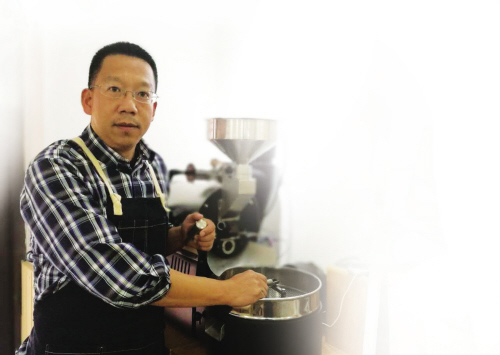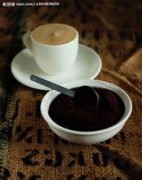Cheng Kun: how does a software engineer express the taste of a coffee?
Follow the coffee workshop (Wechat official account cafe_style) to find the good coffee and the good life.
-- split line

/ photos by Cheng Kun / courtesy of interviewees
Everyone calls him Lao Cheng, but in fact he is not old. Talking to him about the variety and baking of coffee beans, he seems to only laugh, and does not routinely recommend words. People really need to choose which one to drink by their own mouth, while Lao Cheng only laughs foolishly: everyone's taste is different. Like it. Like it.
I asked Lao Cheng to write about him and coffee beans, and I expected him to write a popular science article, sure enough. In this "Coffee Story", which he wrote while preparing for "half Horse", the feeling of a rigorous software engineer writing code is on paper. All right, let's bake a batch of coffee beans with Lao Cheng.
It is already 10 o'clock at night. It is estimated that many people have entered their dreams and those who have not slept are ready to go to bed. I turned on the roaster, preheated the fire, and turned around to weigh the coffee beans that needed to be roasted. The temperature in the roaster is slowly rising. Pour a glass of white water to refresh your mouth and prepare yourself before baking.
Looking at the temperature on the machine-20 degrees Celsius, I have to say that Dalian is a very suitable place for coffee roasting.
Before roasting coffee beans, I need to make a baking plan for each kind of coffee beans, which is determined according to the variety, moisture content, density, sample cup test results, etc.; in addition to the factors of the beans themselves, the temperature, humidity and air pressure of the environment will have an impact on the roasted coffee, and the baking plan of each bean needs to be adjusted according to the indoor and outdoor temperature and humidity at that time.
When the temperature in the roaster reaches the bean temperature, I adjust the firepower and throttle of the roaster, open the computer synchronous recording software, pour the beans into the hopper and start baking.
As the beans enter the furnace, the screen shows that the temperature of the beans in the furnace drops rapidly, reaching the temperature recovery point in about a minute, and then the temperature begins to rise slowly. Through the observation window, I could see that the coffee beans were slowly changing, from turquoise to light yellow, and then darker; then the flavor began to dissipate, from grass to toast to flower, fruit, caramel and other flavors; roasted coffee beans go down from the oven to the cooling tray and cool quickly. After keeping the roasting record of this batch of coffee on the computer, I am ready to start the next batch of roasting.
Usually, the next morning, I test the beans baked last night with my barista in the store, recording each baking process and cup test to ensure the quality and stability of the coffee. Just as there are no two identical coffee beans, there is a slight difference in each batch of coffee, even if the baking curve is exactly the same. No one can be sure how coffee tastes until it is tasted. Maybe that's the charm of baking, which fascinates me.
I used to be a software engineer, sitting in front of the office computer to write code to do projects, is also a good job that many people dream of. But sitting in front of the computer all day long, I think I should have a hobby.
After careful thinking and referring to my own hobby, I bought a coffee roaster in early 2013 and began to practice roasting coffee beans.
At that time, there were few people roasting coffee in Dalian, and there was no one to learn and communicate. I remember that the beans baked for the first time were Yega Xuefei. I consulted the roaster manufacturer over the phone while baking. As a result, a batch of beans were burnt, black and undrinkable.
I have kept these beans for a long time, and I don't know why I don't want to throw them out.
After that, I began to look up information on the Internet, buy baking books, communicate with local coffee roasters, and express the roasted beans to the roasters in Beijing and Shanghai to taste. A little bit, my coffee can be brewed to my friends, and the sense of achievement makes me beautiful.
Later, an Yilin, a teacher in Qingdao, gave a baking class in Dalian. Without saying a word, I signed up to take the SACE roaster course, so I stepped onto the road of professional coffee roasting step by step.
At the beginning of this year, I participated in the sixth "Frog Cup" Baking Exchange Competition, which was attended by 100 bakers from 32 cities in China to bake a designated race bean. I have participated in the "Frog Cup" baking contest three times, it is a pity that I have not been able to get any particularly high ranking, but the competition has helped me a lot. In this competition, for example, the rules increase the specific requirements for the roasting degree of coffee, which is a test of the roaster's basic skill-the ability to observe the roasting degree during the roasting process. Each participating roaster is required to provide not only the roasted coffee beans, but also the baking plan, the baking curve and the cup test after baking. During the competition, the baker discussed online how to bake the bean, how to improve its sweetness and how to keep the fragrance of the flowers.
This kind of communication and sharing allows me to understand the baking ideas and baking methods of the same bean baked by bakers in different regions. I have baked this bean six times in a row, each time the baking curve is a little different, and the taste of the beans will be very different. Two months after the game, I baked the bean again, baked it and gave it to the competition organizers to taste. It was agreed that it was the best baking I had ever done.
With the popularity of coffee, many guests have come into contact with light-roasted coffee, and many coffee lovers like the sour taste of light-roasted coffee. At the same time, most of the guests prefer bitterness to sour. This is a challenge for a coffee roaster-how to express the taste of a coffee? As far as I'm concerned, it doesn't matter whether deep baking or light baking, each bean may not have only one baking plan, do your own baking style. The taste of coffee can not be too bitter or irritating acid, which is my goal at present.
Important Notice :
前街咖啡 FrontStreet Coffee has moved to new addredd:
FrontStreet Coffee Address: 315,Donghua East Road,GuangZhou
Tel:020 38364473
- Prev

Coffee fragrance talking about Innovation and Entrepreneurship
A (Reporter Yang Binhu) on the evening of May 4, the first mass creation salon of Yanta was held in Tiishi Entrepreneurship Coffee. The person in charge of Yanta District and the person in charge of two mass creation spaces in the area and eight entrepreneurs' representatives talked about innovation and entrepreneurship at the May 4th Youth Festival. The District Science and Technology Bureau and the Bureau of Human Resources and Social Affairs interpreted the relevant innovation and entrepreneurship policies on the spot, and the persons in charge of the two Zhongchuang Space were concerned about the development of Zhongchuang Space Construction.
- Next

How many drinks a day? Women who are addicted to coffee are prone to physical problems. Difficult to get pregnant
Professional barista communication please follow the coffee workshop (Wechat official account cafe_style)-▲ women who like to drink coffee should be aware that excessive caffeine consumption may lead to infertility! (photo / taken from LibreStock) Life Center / Comprehensive report Coffee for many people
Related
- Being chased out of the rain in front of Starbucks?! Store: Sheltering from rain under umbrellas poses a safety hazard
- The white moonlight has changed?! Lucky launches "Big Winter Pear American"
- Hand-brewed coffee three-stage method, high-sweet and universal brewing method to share! What does the high sweet water level of hand-brewed coffee mean?
- What is the difference between raw, refined and full espresso coffee? How to extract espresso and taste good?
- A complete list of coffee bean names and their meanings! What is Yejia Shefi coffee? Where is Mantelin coffee?
- What grade does Arida Manor Kaduai coffee beans belong to? What treatment is Arida ASD slow anaerobic sun exposure?
- The milk tea cup becomes smaller?! Overlord Tea Girl launches a new "Return to Yunnan" series
- Accused of selling counterfeit and high-priced coffee beans! Well-known boutique coffee brand "Oukelao" bowed and apologized!
- How to make espresso dumplings? Can I eat coffee and glutinous rice balls together?
- Save the unformed and stagnant powder cakes in one second! What is the problem with stagnant water in the powder bowl of the espresso machine?

